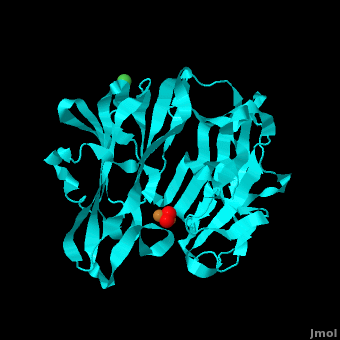Monooxygenase: Difference between revisions
Michal Harel (talk | contribs) No edit summary |
No edit summary |
||
| Line 1: | Line 1: | ||
<StructureSection load=' | <StructureSection load='' size='450' side='right' scene='Journal:JBIC:17/Cv/2' caption='' > | ||
== Function == | == Function == | ||
| Line 5: | Line 5: | ||
'''Monooxygenases''' (MO) catalyzes the incorporation of a hydroxyl group into a variety of substrates. MO catalyzes the reduction of O2 to H2O while oxidating NADPH. | '''Monooxygenases''' (MO) catalyzes the incorporation of a hydroxyl group into a variety of substrates. MO catalyzes the reduction of O2 to H2O while oxidating NADPH. | ||
== | === Peptidylglycine α-Hydroxylating Monooxygenase (PHM)-coordination of peroxide to Cu<sub>M</sub> center. Structural and computational study === | ||
<big>Katarzyna Rudzka, Diego M. Moreno, Betty Eipper, Richard Mains, Dario A. Estrin and L. | |||
== | Mario Amzel,</big><ref >doi 10.1007/s00775-012-0967-z</ref> | ||
<hr/> | |||
== | <b>Molecular Tour</b><br> | ||
In recent years there has been a significant interest in describing the interactions of copper-containing enzymes with O2/H2O2-derived species. The short-lived intermediates resulting from the activation of dioxygen are the key players in the mechanistic cycles in many metalloenzymes. In the enzyme <scene name='Journal:JBIC:17/Cv/3'>peptidylglycine alpha-hydroxylating monooxygenase (PHM)</scene> various reduced Cu/oxygen species have been proposed to act as catalytically competent intermediates, yet their exact nature and their role in the enzymatic reaction is still unknown. | |||
Structural and other studies showed that peptidylglycine α-hydroxylating monooxygenase (PHM) contains <scene name='Journal:JBIC:17/Cv/4'>two non-equivalent copper sites (CuH and CuM)</scene>. CuM serves as an oxygen binding and hydrogen abstraction site, CuH is involved in electron transfer. In the structure of Cu(II)-PHM complexed with hydrogen peroxide determined to 1.98 Å resolution, <scene name='Journal:JBIC:17/Cv/7'>(hydro)peroxide binds exclusively to CuM in a slightly asymmetric side-on mode</scene>. The <scene name='Journal:JBIC:17/Cv/8'>interatomic O-O distance of the copper-bound ligand is 1.5, characteristic of peroxide/hydroperoxide species, and the copper-oxygen distances are 2.0 and 2.1</scene> Å. This Cu(II)-bound <scene name='Journal:JBIC:17/Cv/9'>peroxo moiety interacts closely with a molecule of water</scene>, forming <scene name='Journal:JBIC:17/Cv/10'>hydrogen bonds that stabilize the structure</scene>. DFT and QM/MM calculations indicate that this species is a Cu-bound doubly deprotonated peroxidate and that its energy is similar to that of its isomer Cu(I)-bound superoxide. | |||
</StructureSection> | </StructureSection> | ||
Revision as of 17:39, 7 May 2015
FunctionMonooxygenases (MO) catalyzes the incorporation of a hydroxyl group into a variety of substrates. MO catalyzes the reduction of O2 to H2O while oxidating NADPH. Peptidylglycine α-Hydroxylating Monooxygenase (PHM)-coordination of peroxide to CuM center. Structural and computational studyKatarzyna Rudzka, Diego M. Moreno, Betty Eipper, Richard Mains, Dario A. Estrin and L. Mario Amzel,[1] Molecular Tour In recent years there has been a significant interest in describing the interactions of copper-containing enzymes with O2/H2O2-derived species. The short-lived intermediates resulting from the activation of dioxygen are the key players in the mechanistic cycles in many metalloenzymes. In the enzyme various reduced Cu/oxygen species have been proposed to act as catalytically competent intermediates, yet their exact nature and their role in the enzymatic reaction is still unknown. Structural and other studies showed that peptidylglycine α-hydroxylating monooxygenase (PHM) contains . CuM serves as an oxygen binding and hydrogen abstraction site, CuH is involved in electron transfer. In the structure of Cu(II)-PHM complexed with hydrogen peroxide determined to 1.98 Å resolution, . The Å. This Cu(II)-bound , forming . DFT and QM/MM calculations indicate that this species is a Cu-bound doubly deprotonated peroxidate and that its energy is similar to that of its isomer Cu(I)-bound superoxide. |
| ||||||||||
3D structures of monooxygenase3D structures of monooxygenase
Updated on 07-May-2015
Methane monooxygenase See Methane monooxygenase
Camphor 5-monooxygenase See Cytochrome P450 Luciferin 4-monooxygenase and Alkanal monooxygenase See Luciferase
ReferencesReferences
- ↑ Rudzka K, Moreno DM, Eipper B, Mains R, Estrin DA, Amzel LM. Coordination of peroxide to the Cu(M) center of peptidylglycine alpha-hydroxylating monooxygenase (PHM): structural and computational study. J Biol Inorg Chem. 2012 Dec 18. PMID:23247335 doi:10.1007/s00775-012-0967-z
